By Kyle Pinion and Harper Harris
In one week, First Second will be producing the prequel to Paul Pope’s critically lauded and Eisner Award winning Battling Boy entitled The Rise of Aurora West. This new tale, co-written by Pope and J.T. Petty, features art by David Rubín and centers on the journey of Aurora West, daughter of Arcopolis’ pulp inspired hero: Haggard West, who seeks to uncover the mystery behind her mother’s death and to do so without her famous father discovering her mission. It’s a fascinating expansion on the mythos Pope laid out in the initial Battling Boy graphic novel, and we were fortunate enough to chat with Rubín regarding his work on this new title and what we can expect next from this rising talent.
Where did you get your start in the comics industry and was it based upon American comics or more of the European variety? Both?
I started to publish my work in 2001, first in some Spanish fanzines and magazines, and then with my first graphic novels, published in Spain by Astiberri editions. Astiberri works hard to sell my titles to other publishers in other countries, and now you can find my books in French, Italian, Czech, and soon in English too.
I like to mix the different traditions in my own work; American comics, European BD and Japanese manga. I like to read both, and both are reflected in my style.
What are your key influences as an artist?
From American comics: Jack Kirby (he’s my favorite author), Frank Miller, Alex Toth, Mike Sekowsky, John Romita Sr. & Jr., and Bob Oksner.
From European BD: JC Forest, Moebius, Peellaert, Blutch, and Hugo Pratt.
From Japanese Manga: Osamu Tezuka, Go Nagai, Shigero Mizuki, Shotaro Ishinomori, and Suehiro Maruo.
And some Spanish artists like Javier Olivares, Santiago Sequeiros, and Miguel A. Robledo.
But influences in my work aren’t provided only by comics; the music, the cinema, the painting, and other kinds of pop culture also influence my work.
What were some of your earlier projects during the beginning phases of your career?
“Dónde nadie puede llegar” was my first long project. It was a story of love, loss, and unhappy superheroes. It’s included in my first graphic novel with Astiberri: “El Circo del Desaliento”. It was published in France and in Italy, too.
“La tetería del oso malayo” was my second graphic novel with Astiberri. It’s a compendium of different short stories with a common link, the tearoom where those stories happen. It’s a very emotional and sad book.
And the third graphic novel of my early work was called “Cuaderno de Tormentas” and was published in Spain by Planeta DeAgostini. It’s a bizarre book about the search for inspiration, about the torturous way of creativity – much more darker and experimental than my previous books.
How did you end up getting your first works published, and who were you working with at the time?
In my early years as a cartoonist, I started the Polaqia collective with other artists.
At that time, none of us had published professionally, and the unique option for us was self publishing our work.
Polaqia collective existed from 2001 to 2011, and we published a lot of great stuff by ourselves and other artists like Dylan Horrocks, Miguel B. Nuñez, Juan Berrio, and a lot of artists from all over the world.
Several members of Polaqia are professional artists now, like the recently Eisner Awards nominated Emma Ríos (“Pretty Deadly,” Image) or José Domingo (“Adventures of a Japanese Businessman,” Nowbrow) and myself. Polaqia was the beginning for us.
At what point did you become a part of The Rise of Aurora West team? Were you a fan of Paul Pope’s work?
Yeah, I like Paul’s work so much! He’s one of the artists who influenced my work.
I remember that in the middle of 2013 – before Battling Boy came out — I’d received an e-mail from Paul in which he asked me if I’d want to collaborate with him and First Second in a spin-off of Battling Boy.
At that moment I was very busy working on my graphic novel Beowulf with Santiago García, but…Oh, Boy!…that kind of thing only happens once in a lifetime! And, of course, I said YES.
What was the working relationship like between yourself, Paul Pope and JT Petty? With whom were you in most constant contact during the development of the graphic novel?
We did some short but intense pre-production work at the beginning of the project. I made a lot of sketches of the characters, and they sent to me a lot of reference stuff like photos, old films and tv serials, etc…everything I needed for playing well with the new universe created by Paul.
But when I was starting to working on the pages, they gave me a lot of freedom. When I have a batch of pages, 20 or 30, in pencils, I sent it to JT, Paul and the staff of First Second. Everything that was said to me is “Oh, GREAT!” “WOW!!”…so I think that I’m a lucky guy!
JT always shows those pencil pages to his little daughter. She’s the real beta-tester of Aurora West’s books! And until this moment, everything I’ve sent works fine for her, haha!
With Paul Pope obviously being an artist himself, did the scripts already have pre-figured design concepts or did Pope and Petty give room for your own ideas?
It’s a team effort; I use some of Paul’s previous ideas in Aurora West and Paul used some of my ideas in Battling Boy 2.
Paul and JT’s script is very detailed, but they haven’t any problems with me including a lot of new ideas in it when I do the storytelling. They make my work easier!
Was this story always intended to be two volumes? Are you working on the second half already or will there be a significant break between the work on the two books?
Yes, Aurora West’s story was two volumes since the beginning.
And I’m already hard at work on the second volume. I’ve already finished more than 80 pages of penciled art.
I’ll be finished with book two for the end of January 2015…I think.
Will The Fall of the House of West dovetail with the plot of Battling Boy or will be it wholly separate?
“The Fall…” ends when Battling Boy begins, the four books –BB1&2 and AW1&2 – will make a single story, I think.
It’s not necessary for you to have already read Battling Boy to enjoy and understand the story of Aurora West, but if you already read Battling Boy, your experience like reader with The Rise of Aurora West is going to be more powerful.
What is your favorite aspect of being able to flesh out the world of Battling Boy? Do you have a particular addition of your own that you’re especially proud of? Is there a wrinkle or element that is very specifically “David Rubín”?
The Battling Boy universe is young and very unexplored as yet.
It’s a world that’s 100% Pope, yeah. But at the same time, that world only has the two hundred pages of Battling Boy, and that gives me a lot of leeway to play in it — and to provide it some of my ideas.
Arcopolis, the city where the action happens in Battling Boy and The Rise of Aurora West, are darker in Aurora West than in Battling Boy. It’s the same city, the same architecture, but it’s different. There are also plenty of new characters that I designed for the Battling Boy universe, like Medula and her gang of catfishmidgers, Croward, and a number of new monsters and humans, who all appear for the first time in The Rise of Aurora West.
Anyone who has read some of my own books could find a lot of references and similarities, and this the case because the world created by Paul is very rich and full of possibilities.
How would you compare Aurora and Battling Boy as heroes? What makes Aurora stand apart?
They’re some similarities between Battling Boy and Aurora; both are learning to be heroes, and both have a lot of doubts about themselves and their own fate.
But Battling Boy came from a fantastic world full of gods and heroes, a world where everything is possible, while Aurora grew up in a world with only one hero; her father, in a city under siege, full of monsters and menace.
And that makes a big difference in the personality of both.
All of the sound effects are drawn into the art rather than photoshopped in, was that a conscious choice for stylistic purposes?
I like to draw all these elements — the sound effects, the balloons — by myself. I think it gives a more organic look to the pages, and helps to make the timing more fluid than if you put this elements in a page with a computer in a post-production process, or if someone else puts them in.
I try to make them by myself in every one of my books. I think that is the best way.
Why black and white instead of fully colored pages? Was that an economic choice or a storytelling one?
That was an editorial decision. When I was asked to do this project, First Second had already decided that Aurora West’s book would have B&W final art.
But that editorial choice was good for my work, I think, because I had to go in different ways for my storytelling than if the book had been published in full color.
B&W requires much more of the artists. You must generate feelings in the reader with only one color ink, the same feelings that people feel in seeing full color art. To make that possible, you need to express more using storytelling.
What sort of challen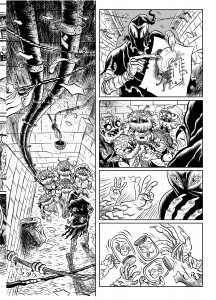
Good question!! With color that is so easy; one blue, one red, one green…but in B&W, with these capes, everybody looks the same!
There are some tricks to make them distinguishable; if you look, each of them has different elements in their costumes. In addition, the acting not is the same for them all; Sadisto is more theatrical, more broad than the others, Coil is more strong and purposeful, etc…
What are your primary artistic techniques when working on a book like this? What kind of materials do you use?
I drew the storyboard for the book on little pieces of paper, then I scan the story and print a blue version in A4 paper size of the story pages. Then I make the final and draw over it, with a pencil.
When the pencil pages are done, I scan the result and print in blue in B4 size papers (a size between A4 and A3) and do my inks there, with a brushpen.
Inks done, I scan – again — the pages and includes the grey tones in Photoshop. I add some other additional details of the inks digitally, like the splatter of ink in some panels, etc…
There are other ways to draw a comic page, better, for sure, but this one works well for me. And you have two original pages of each page! One in pencils and one in inks!
You can see a graphic explication of my work process in Aurora West in my blog:
http://detripas.blogspot.com.es/2014/02/historia-de-una-pagina.html
The Rise of Aurora West has a very 1930’s Serial look, particularly in its Egyptian segments, but more or less throughout. Where does that come from? (as it signals a somewhat sharper turn from the Kirby-esque Battling Boy graphic novel)
Paul and JT wanted a 1930’s tv serial look for these sequences, a graphic atmosphere like Doc Savage or other pulp stories.
Paul sent me some chapters of 1930’s Flash Gordon serial, which is amazing, and I tried to get the tone of this type of work, old but fashionable, in the panel of these segments.
Those Egyptian sequences are flashbacks, which helps to that old fashioned-phantasmagoric atmosphere work just fine.
What was the most difficult segment of the script to illustrate? Additionally, what was the most fun part?
Both are the same part!! The long final sequence with the confrontation of Haggard and Aurora with Medula and Sadisto’s gang was my favorite.
It’s a long sequence, with a lot of action, a number of points of view, and mini sequences as well.
It has everything; tons of action and adventure, shootings, explosions, melee, hue-and-cry….and a lot of drama, surprises and emotional moments.
There were harder segments to illustrate, but, undoubtedly, this was the most fun!
As for other upcoming work, you have an adaptation of Beowulf coming. What is about Beowulf that attracts you as an artist, particularly for such an oft-told story? And with the English language release of The Hero (a re-telling of Hercules) coming through Dark Horse, do you have a particular affinity for mythological heroes and why?
I’ve liked mythology since I was a child; the gods were the first superheroes ever!
When I created The Hero, I had wanted to recover the emotions that I lived when I first read SH comics as a child — this pure emotion, these “bigger-than-life” stories.
That book is my love letter to the genre of superheroes, especially to Jack Kirby’s work.
But if I didn’t make a graphic novel about the nostalgia for the old superhero comics and pop culture; I’d make a book about myths, heroes, monsters, but with everything packed in the sad, visceral and very emotional drama of a human being.
My approach to Beowulf was more a coincidence than something I sought out.
I was reading in Santiago Garcia’s blog that his project of a Beowulf graphic novel with Javier Olivares was cancelled.
I was really angry when I saw that notice – I really WANTED TO READ that graphic novel! – and I immediately called Santiago and said to him: “Hey man, Beowulf can’t fall in oblivion! I’m going to draw it and make it a reality!!!”
Santiago accepted my offering and the rebirth of Beowulf project began!
When can we expect to see Beowulf in stores and do you have any other projects that you’d like to share any news about?
The English version of our Beowulf arrives at stores in 2015, published by Image Comics.
And as for future projects…by the moment I’m making a new graphic novel with high concept Sci-Fi and a scathing critique of the current political and economic system, with the spanish writer Marcos Prior. I think that will be finished by the end of 2015.
And in the meantime, I’m drawing a four issues mini-series for Boom! Studios, a completely new and original series.
You can purchase Battling Boy: The Rise of Aurora West in stores on September 30th.


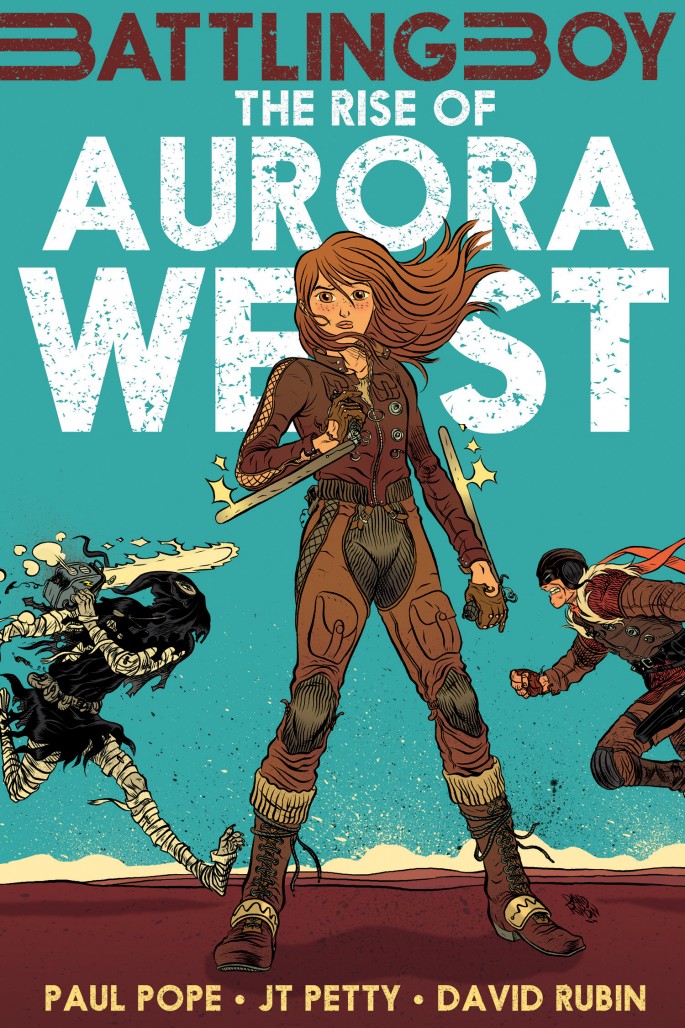
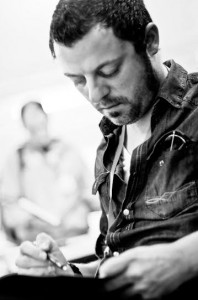
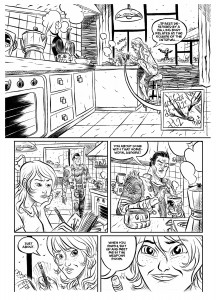
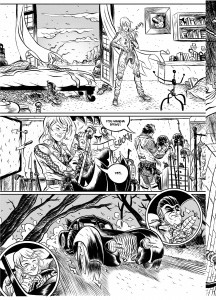





This book is so damned small.
I love Paul Pope but the book format size of his book, The Battling Boy book was quite tolerable but this and the second book, The Fall of the House of West are hard to read at normal range. Letters are so tiny, you had to press your nose on it to see them clearly.
Really, I don’t understand why 1st Second publisher decided this book size.
Most of Paul previous books such as THB, Escapo, etc., were comic book size and larger.
I once wrote to 1st Second if they plan to reprint all Aurora West books at larger size. They replied it is not going to happen.
Comments are closed.